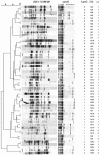Systematic molecular characterization of multidrug-resistant Mycobacterium tuberculosis complex isolates from Spain
- PMID: 15750087
- PMCID: PMC1081258
- DOI: 10.1128/JCM.43.3.1220-1227.2005
Systematic molecular characterization of multidrug-resistant Mycobacterium tuberculosis complex isolates from Spain
Abstract
We used spoligotyping and restriction fragment length polymorphism (RFLP) of the IS6110-insertion sequence to study the molecular epidemiology of multidrug-resistant (MDR) tuberculosis in Spain. We analyzed 180 Mycobacterium tuberculosis complex isolates collected between January 1998 and December 2000. Consecutive isolates from the same patients (n = 23) always had identical genotypes, meaning that no cases of reinfection occurred. A total of 105 isolates (58.3%) had unique RFLP patterns, whereas 75 isolates (41.7%) were in 20 different RFLP clusters. Characterization of the katG and rpoB genes showed that 14 strains included in the RFLP clusters did not actually cluster. Only 33.8% of the strains isolated were suggestive of MDR transmission, a frequency lower than that for susceptible strains in Spain (46.6%). We found that the Beijing/W genotype, which is prevalent worldwide, was significantly associated with immigrants. The 22 isolates in the largest cluster corresponded to the Mycobacterium bovis strain responsible for two nosocomial MDR outbreaks in Spain.
Figures





References
-
- Angarano, G., S. Carbonara, D. Costa, A. Gori, et al. 1998. Drug-resistant tuberculosis in human immunodeficiency virus infected persons in Italy. Int. J. Tuberc. Lung. Dis. 2:303-311. - PubMed
-
- Bifani, P. J., B. Mathema, Z. Liu, S. L. Moghazeh, B. Shopsin, B. Tempalski, J. Driscol, R. Frothingham, J. M. Musser, P. Alcabes, and B. N. Kreiswirth. 1999. Identification of a W variant outbreak of Mycobacterium tuberculosis via population-based molecular epidemiology. JAMA 282:2321-2327. - PubMed
-
- Blázquez, J., L. E. Espinosa de Los Monteros, S. Samper, C. Martín, A. Guerrero, J. Cobo, J. Van Embden, F. Baquero, and E. Gómez-Mampaso. 1997. Genetic characterization of multidrug-resistant Mycobacterium bovis strains from a hospital outbreak involving human immunodeficiency virus-positive patients. J. Clin. Microbiol. 35:1390-1393. - PMC - PubMed
-
- Caminero, J. A., M. J. Pena, M. I. Campos-Herrero, J. C. Rodriguez, I. García, P. Cabrera, C. Lafoz, S. Samper, H. Takiff, O. Afonso, J. M. Pavon, M. J. Torres, D. van Soolingen, D. A. Enarson, and C. Martín. 2001. Epidemiological evidence of the spread of a Mycobacterium tuberculosis strain of the Beijing genotype on Gran Canaria Island. Am. J. Respir. Crit. Care Med. 164:1165-1170. - PubMed
Publication types
MeSH terms
Substances
LinkOut - more resources
Full Text Sources

